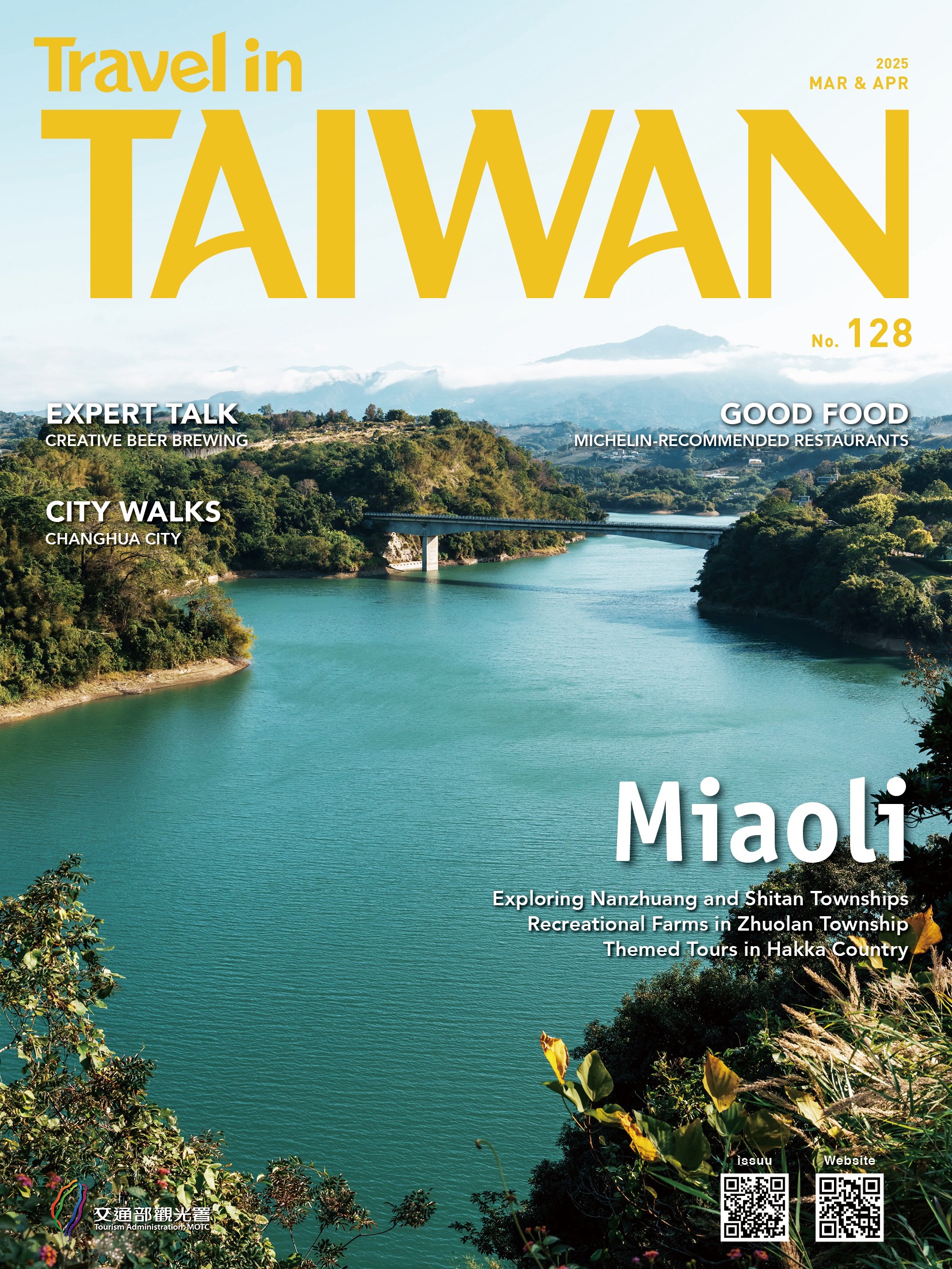Restaurants Serving Traditional Taiwanese
TEXT I HAN CHEUNG
PHOTOS | CHEN CHENG-KUO
While Taiwan is perhaps best known for its night-market foods, the island boasts a wealth of signature recipes shaped by its diverse geography and cultural influences. From intricate, time-consuming banquet creations to time-honored everyday plates, many Taiwanese-cuisine restaurants strive to recreate these classic flavors in their menu, often with a modern twist.
Feng Delicious
Lively conversation fills the bright, bold-colored dining area at Feng Delicious as friends and families gather after work for a taste of home cooking. The restaurant aims to provide a relaxed, casual atmosphere similar to that of bustling stir-fry joints, but in a more polished setting with an intriguing and innovative menu. Groups looking for quietude can opt for one of the private rooms, which are quite soundproof.

The restaurant is run by Wowprime Corp., which is primarily known for its steakhouses but now operates nearly 500 eateries covering a variety of cuisines in Taiwan and China. Feng Delicious was launched in 2019 in a bid to recreate the uniquely Taiwanese flavors of “mom’s cooking.”
The problem was that there wasn’t one standard way of preparing these dishes, and arguments often arose while attempting to standardize the recipes, as staff members had different versions dear to their memories. The chefs adjusted, experimented, and eventually settled on a menu everyone approved of, which includes banquet dishes and creative takes on classics.

Last August, the restaurant unveiled a brand-new look and menu across its four branches in Taipei and Taichung, opting for an orange-and-green palette with retro-chic furnishings such as window grilles. The new menu includes 13 innovative dishes, created using locally sourced ingredients whenever possible.
One notable new offering is the crispy pork knuckles, which are first braised and then deep-fried, and finally drizzled in a soy-based sauce made with 13 spices. The numbing spiciness and layers of different fragrances build up slowly in the mouth, and the texture is both crunchy and chewy. Another hot item is the shacha sauce radish cake, which is flash-fried at high heat so the inside is still soft.


The four-cup chicken is a variation of the usual three-cup recipe using soy sauce, rice wine, and sesame oil. The fourth cup is a shot of huadiao wine, poured into the piping-hot ceramic bowl used just before serving. And the eggs fried in pure black sesame oil with aged ginger slices are aromatic and go well with white rice. Both runny and baked versions are available.

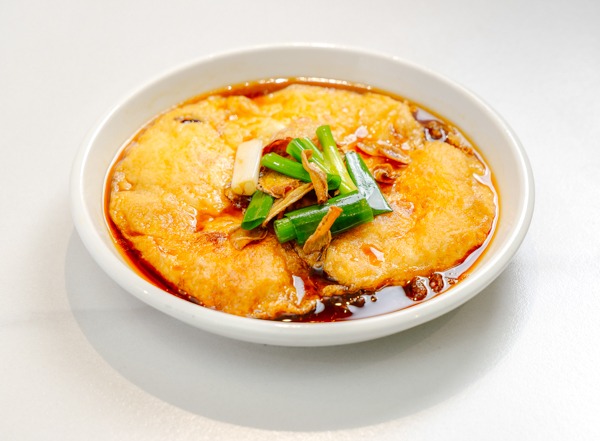
Feng Delicious
丰禾台式小館
Tel: (02) 2507-6808
Add: 2F, No. 146, Sec. 2, Nanjing E. Rd., Zhongshan Dist., Taipei City
(台北市中山區南京東路二段146號2F)
Hours: 11:30am-2:30pm; 5:30pm-10pm
Website: www.veggtable.com
Truly Taiwanese Cuisine
Those who have visited Wai’ao Beach in Yilan County will surely have noticed the stately, all-white Middle Eastern-style palace building between the shore and the coastal highway. It was built by the county’s Lin family, who made their fortune in the restaurant business in Saudi Arabia. In 2019, they returned to their roots and opened Truly Taiwanese Cuisine in Taipei to bring the distinctive specialties of their home region to diners in the metropolis – albeit infused with modern, creative elements.
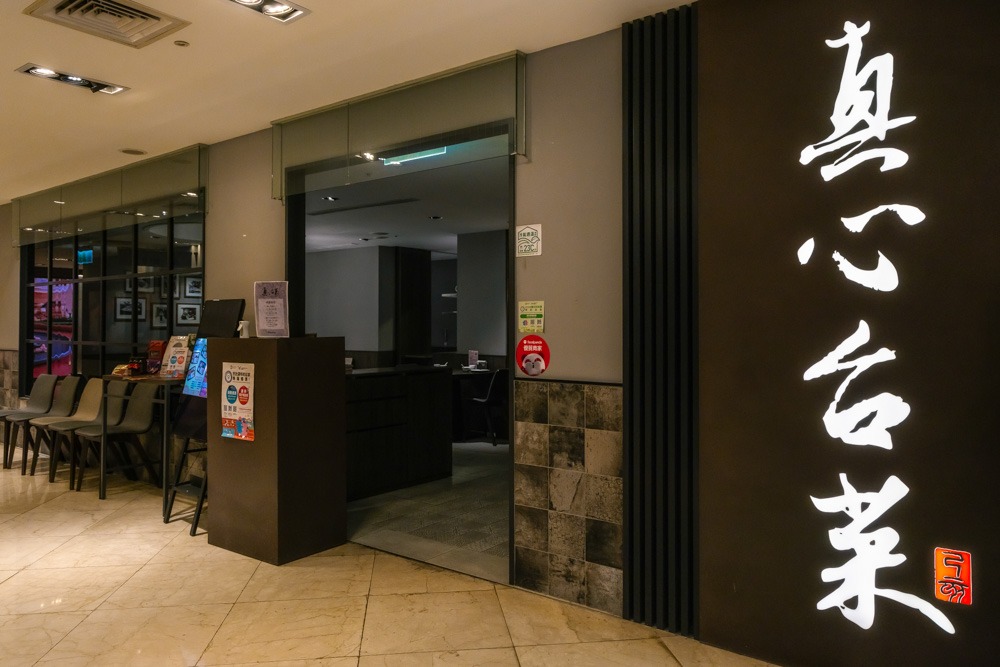
The restaurant is nestled in the basement of the Breeze Center shopping mall complex in the capital’s trendy East District. It’s somewhat hard to find, but just be patient and follow the signs. The dark-toned wood decor is elegant yet cozy at the same time, accentuated with vintage decorations, art pieces, and old photos. The layout, with round tables predominant, is designed to accommodate groups of all sizes, and diners can also book one of the private rooms.

Head chef Wang Sheng-yao grew up in Taipei, but has ancestral roots in Yilan. After two decades in the industry exploring different cuisines, he now aims to reintroduce the nostalgic flavors of his family kitchen to a new generation. In the past, many of these dishes were often prepared in copious amounts for family gatherings, banquets, and temple festivities, the more lavish the better. But this notion no longer suits today’s society, as younger customers with smaller families prefer more refined and intimate dining experiences that also emphasize visual appeal. While retaining the essence of the cuisine, Wang has introduced modifications of Yilan classics into today’s menu.
Dried radish omelet is a quintessential offering found in many restaurants serving Taiwanese cuisine, but Yilan’s “wet” version is distinct as the radish is pickled in sugar and salt water, making for a softer texture instead of the traditional crunch. It pairs well with the fluffy scrambled egg that’s almost 5cm thick, the aroma enhanced with garlic sprouts. It is ideally consumed with premium chewy Koshihikari rice from Yilan’s Wujie Township.

“Dragon Phoenix Leg” is a northeastern Taiwan specialty, harkening back to the days when families couldn’t afford to serve drumsticks to every member after sacrificing chickens during their annual ancestor worship ceremony. For the hungry children, locals concocted this morsel by wrapping leftover ingredients in pork caul fat, sticking a rib bone into the end of the membrane and deep-frying it. Truly Taiwanese Cuisine’s version includes fried spring onions of Sanxing Township fame, water chestnut, lard, pork, and shrimp, and comes with a red miso dipping sauce.

The real drumstick dish, however, is a boneless “drunken” creation rolled up, steamed in red-yeast rice, and then marinated for 20 hours in Shaoxing wine. Served cold, it emanates a fragrant alcoholic flavor that is distinct but not overwhelming, with slight fermentation undertones.

The highly esteemed banquet dish of pig belly soup with pickled vegetables is very time-consuming to concoct and is hard to find in restaurants nowadays. Pickled cabbage, mushrooms, carrots, bamboo shoots, and pig stomach are sliced into strips and tied together with dried calabash strings, creating a delightful textural medley.

Another favorite is the mullet roe fried rice, which is quickly cooked in intense heat to draw out the umami flavor of the salted roe. The rich taste permeates the evenly separated grains, blending well with the spring onion. It’s served in a heart shape, referring to the Chinese characters translated as “Truly” in the restaurant’s English name, literal translation “true + heart(ed).”
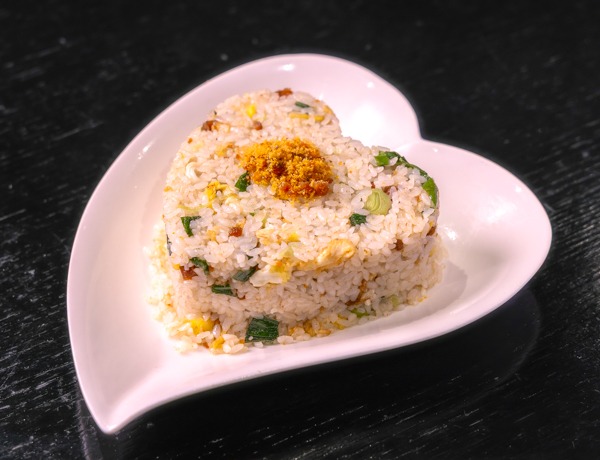
A variety of drinks is also available. The sugarcane juice with oolong tea is not too sweet and serves as a refreshing palate cleanser, and the white gourd and lemon juice is another popular choice. As well, affordable seasonal lunch boxes are available for those on the go; a highlight item is the garlic “tiger palms,” which are tendinous pork joints.
Truly Taiwanese Cuisine
真心台菜微風廣場
Tel: (02) 6600-1280
Add: GF, No. 39, Sec. 1, Fuxing S. Rd., Songshan Dist., Taipei City (inside Breeze Center)
(台北市松山區復興南路一段39號G樓)
Hours: 11:30am-10pm
FB: www.facebook.com/trulytaiwanesecuisine
Mipon
For a luxurious Taiwanese-cuisine experience, head to Mipon, which has earned a Michelin star four years in a row. It’s located on the third floor of the opulent Grand Mayfull Hotel in a high-end neighborhood in Taipei’s Dazhi area, and its versatile menu accommodates banquets, business meetings, as well as intimate family dinners. The spacious dining hall can seat 190 people, and there’s also a large private booth and five connectable smaller ones. The extravagant yet tasteful interior is well-illuminated with natural light, and of special note are the floors made with a special type of decorative marble that’s usually used on walls.
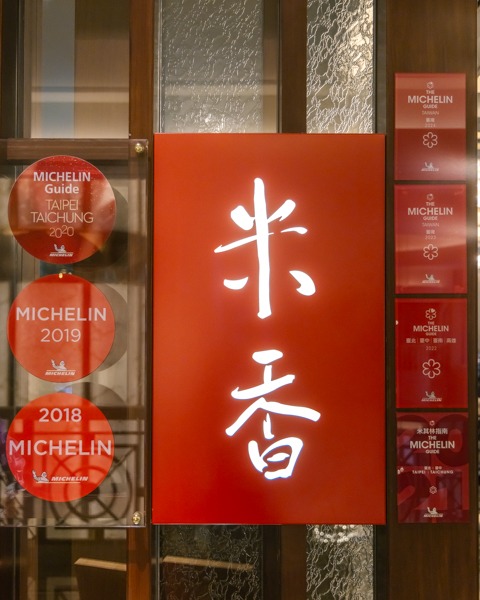
“Mipon” is the Taiwanese pronunciation of the characters for “rice fragrance,” the name honoring the island’s agricultural heritage and the ubiquitous grain that’s the essence of local cuisine. The private rooms also echo this theme, named after the solar terms of the farmers’ calendar. The ingredients used in the restaurant’s culinary works are locally sourced, organic, and adjusted according to season.
Taiwanese cuisine is broadly defined and allows for much interpretation, says head chef Lin Chi-fung. There’s not a standard way to make a certain dish since all ultimately originate from the home kitchen, where each family follows its own inherited recipe. Most crucial is the use of local spices and flavorings such as pure sesame oil and rice wine, which anchor the memories of Taiwanese taste buds.
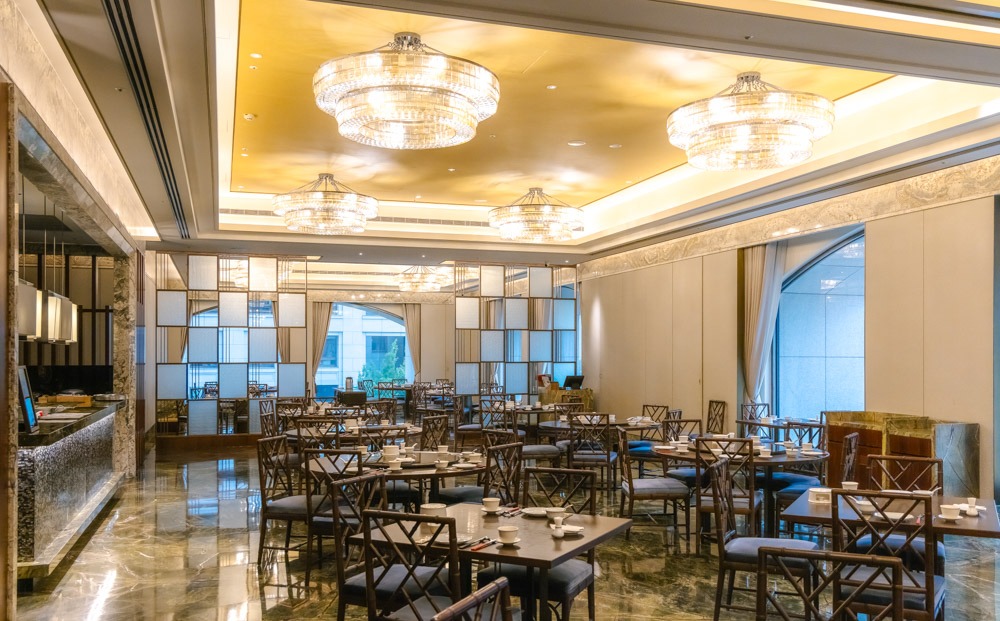
With 40 years of culinary experience across the globe, executive chef Chen Yung-hua excels at infusing his creativity and influences into complex, laborious classic recipes and sumptuous banquet hall offerings, as well as high-quality dishes created by private cooks for wealthy households and simple home-style standards. In the past, restaurant plates often came with intricate sculpted decorations, and Mipon also strives to revive this fading art – this option is available upon request.
The “3.5 cup” spring bamboo and abalone is another twist on the aforementioned traditional three-cup preparation, with an extra half-cup of Shaoxing wine poured onto the sizzling pot at the table. The bamboo shoots are meticulously scored so that the flavors permeate the entire piece, and this dish requires precise control and timing over the fire. The result is a medley of textures and flavors, with the aroma of the Shaoxing wine filling each bite.

Another unique innovation is the fried pork jowl with peanut sprouts. Peanut sprouts are still relatively rare on Taiwanese menus, their crunchy texture and sweet taste a departure from the common bean sprouts. They pair well with the tender, evenly marbled pork cheeks, which are fried in slightly spicy XO sauce.

The hand-dressed crab with three types of egg is an example of a complex dish that requires pre-ordering. The mud crab is first steamed to preserve its flavor, with the meat and paste removed manually and stir-fried with scrambled egg and chunks of thousand-year egg. A crab-juice broth is then poured on, with egg white added at the end to provide a thicker texture.
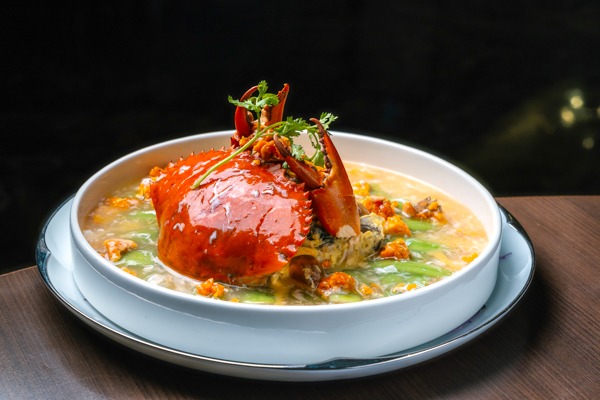
Smaller groups can order Mipon’s version of pickled radish omelet, which uses whole radishes instead of the usual dried scraps of the vegetable. The restaurant’s signature offerings are the fish skin stew with Chinese cabbage adorned with a crunchy garnish made from crispy duck egg, and the tangy glazed fried pork ribs with black jujube dates. The steamed chicken with a special sauce made with chili, garlic, and lemon juice is also worth a try, as well as the beef with manganji green pepper.
For dessert, Mipon offers almond soup in the winter and chilled almond tofu in the summer, which are made from scratch using authentic ingredients, crafting a taste more subtle and organic than the artificial flavoring commonly used elsewhere.
Note: Some ingredients of the dishes on the menu are seasonal and will be adjusted according to the season.
Mipon
米香台菜餐廳
Tel: (02) 7722-3399
Add: No. 55, Lequn 2nd Rd., Zhongshan Dist., Taipei City (inside Grand Mayfull Taipei)
(台北市中山區樂群二路55號)
Hours: 11:30am-2:30am, 6pm-9:30pm
FB: www.grandmayfull.com/dining/MIPON
About the author

Han Cheung
Han Cheung moved back to his adolescent stomping grounds of Taiwan in 2015 from frigid Wyoming, where he was the editor of the small town Rawlins Daily Times. He has a Master’s in Journalism from the University of Missouri and has reporting experience in the US, Latin America, and Taiwan.




